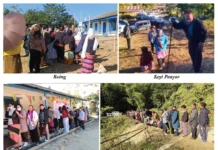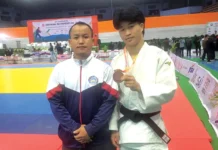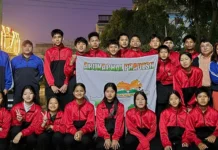Stories, Sorrow, and Strengthening Relationships
[ Dolly Kikon* ]
The 10-year anniversary of the Covenant of Reconciliation is an important moment for us. It is a moment to celebrate the efforts of a movement that was instrumental in reducing the factional violence and encouraging Naga people to embrace a vision of reconciliation.
As I began to reflect on this task – to contribute 1500-word essay – an exhaustion set in. Will I make sense writing about this monumental initiative? Voices of critiques who rejected the idea of Naga reconciliation, underlined the weakness and flaws of members involved in the initiative, their lack of understanding Naga politics, or being blind to tribal and class politics, started to surface in my mind. I began to worry about the language and the purpose of this task and began to fear those who will read this essay and relegate it as a piece of rubbish, and many others who will call me a dreamer. I began to censor my thoughts and set up a theoretical framework that would perhaps privilege my intellectual ability and depart from anything sentimentally Naga or ordinary that we witness every day in Naga society. I almost evacuated my soul from this essay.
And then I remembered a story. When I was child my mother told me a Lotha Naga tale called Apfu Le LeLe. In Lotha Apfu means mother and Le LeLe the sound made by villagers to communicate and guide the cattle to the barn at sunset. In my mother’s version the story takes place in a faraway Lotha village. Once upon a time, a happy family – mother, father, daughter, and an infant baby boy – lived together. One day the mother found out that a small pair of antlers were growing on her head. She was turning into a deer. Knowing that her husband would kill her (as was the custom when humans turned into animals in the village), she went away to the jhum field. As days went by, the father grew suspicious. When he arrived at the jhum fields and discovered that his wife had turned into a deer, he began to hunt her down. Rushing to the upper elevations of the field, the daughter waved her scarf shouting, “Apfu Le LeLe” and warned her deer/mother to flee.
The father eventually killed the deer/mother and cooked the meat for the household that evening. When the daughter refuses to eat it, the father is enraged, and she is reprimanded. She has no agency to reject this offering. As a member of the household, she must participate in this activity. Finally, the father summons the daughter and a conversation takes place.
Father: Here, take a piece of the heart.
Daughter: No. It is my mother’s heart. With this heart she loved me, so I will not eat this piece.
Father: Here, take a piece of the thigh.
Daughter: No. It is my mother’s thigh. I sat on the thigh and she sang for me, so I will not eat this piece.
Father: Here, take a piece of the feet.
Daughter: No. It is my mother’s feet. She carried me on her back and walked me to places, so I will not eat the feet.
Father: Here, take a piece of the eyes.
Daughter: No. It is my mother’s eyes. With these eyes she lovingly looked at me and loved me.
Eventually the father forces the daughter to pick a piece of meat, but she throws it away beside a river and the meat becomes a plant. The story has a happy ending though as the mother rolls down a ball of yarn from the clouds and takes away the children. As a child, I teared up every time my mother narrated the conversation between the father and the daughter. I marveled at the speech of the daughter and the strength of the mother’s spirit to stay alive and transform into different elements – from a deer to a plant to a woman floating in the clouds – just to remain connected and communicate with the children who longed for her.
As an anthropologist I have narrated this tale in my precious work on pathos and food (Kikon 2018), yet I offer this story again to reflect on something deeper about our society this time. The question is how to think about Naga culture responsibly and interrogating the silences around us. Like many indigenous cultures around the world, we are becoming more vibrant through embracing new ways to express our thoughts, aspirations, and politics.
Yet, as we witness the emergence of creative writers, thinkers, artists, and poets who are conscious of their craft and thoughts, we also face the danger of being indifferent to the ongoing transformation around us. We face the risk of delivering an exclusive narrative about Naga society and culture. Indifferent and lacking in solidarity towards our neighbors and communities around us, we begin to design a Naga culture that rejects any kind of change. On one end of the spectrum, it is a colorful shallow culture packaged for consumers seeking a 2-minute indulgence in ‘Naga culture’, nothing deep or intense. And on the other end, it is a festering and sorrowful history we want to leave it behind in the ‘past’.
Once an academic in New Delhi told me that she moderated a conversation with ‘smart and articulate’ Naga intellectuals in Jawaharlal Nehru University (JNU). She beamed and said, “Young Naga intellectuals said they do not care about the Indo-Naga peace process or the Naga reconciliation activities. They said they were fed-up and wanted nothing to do with Naga politics!”
I remember this conversation not because it was the first time I had heard about such reactions from smart and articulate Nagas. I remember this moment because of the radiant smile of the face of the academic who narrated this story. Disguised as an assault, that smile sought to render Nagas people as ‘fed up’ with ourselves, our history, and our present state of being. What does it mean to be ‘fed-up’ of the Naga political process or of the Naga people’s attempts for peace and reconciliation? How do we calculate the loss of lives, limbs, souls, and our humanity in the Naga conflict? In how many ways do we mask our sorrows and pains every day as we hear about injustices around us? And what kinds of conversations take place in the widow’s kitchen when politicians build their houses with Italian marble and erect high walls? How do the wealthy bureaucrats cage themselves in their private prisons and kill their soul with lifeless gadgets and material possessions? And what kinds of poetry and politics flows out of the air-conditioned bedrooms of smart, well educated, and articulate Nagas living behind the high walls as their nimble fingers tap away on the latest iPhone?
The height of the walls and the opulence of the powerful will not measure the achievements of the Naga people. Neither will the rationalization of indifference capture the depth of our wisdom and history. Who will decide what kind of Naga society represents us now and, in the future to come? It is not the power of the mighty who carry guns and zip past as VIPS; it is not the tribal councils who ban writers and excommunicate members of the community; it is not those who legitimate why they assassinated Nagas who spoke up; it is not the blind believers who rejected addicts as members!
As we dabble and play with the radiant colors and designs of our shawls and mekhelas, perhaps we can think about the threads that secures the materials and the beads that adorns our tribal bodies. Let us think about our futures wrapped up, entangled, and interconnected in the possibilities of a living culture. A culture where we hear the voices of our mothers and elders from the past whisper the deep wisdom of our people. Let us bow our heads together and seek the signs and secrets about the meaning of life, let us recognize the importance of dialogue and communication.
How do we begin to talk about a static and suffocating culture, an oppressive culture soaked in the blood of brothers who turned against one another, families broken by mistrust, and communities without respect and honor for one another?
I think about the story of Apfu Le LeLe and the reflections of Naga students in JNU and how, in my generation, we have had to traverse different forms of seeking answers to our rage and sorrow. From the oral world of story telling the textual forms where we tremble with anxiety as we strive and burn our minds to give shape to our thoughts into a language that will frame our being and become the bridge of our imagination and dreams.
And just when I am about to convince myself that I have mastered the art of the text and the written form, I am embarrassed because I start failing to capture the tears and the pains of little children already exposed to violence and poverty. The aspirations and fears of our youth who become migrants in faraway lands, the beautiful daughters of subsistence jhum cultivators who sell their souls to feed their belly, and the artless lies from the lips of the powerful that we have conditioned our souls to digest. At such moments, I close my eyes and reach out to the stories of my elders that I inherited from my mother and I offer it to the smart and articulate students who will write and shape our future. As I feel their pain and the frustration and fumble to find a form to account for this moment, not all is lost. Once again, there is hope.
We still have the power to listen to stories; stories about one another and about our past and present. Stories about our differences and our similarities, stories about how our laughter merges as it echoes down the valley, stories about our forebearers, stories about our dreams to reconcile and heal together.
Reference:
Dolly Kikon, “Eating Akhuni in India” in Kiranmayi Bhushi (ed.), Farm to Fingers: The Culture and Politics of Food in Contemporary India. Cambridge University Press, 2018.
About the author:
*Dolly Kikon teaches Anthropology, Development Studies, and Gender at The University of Melbourne in Australia. She is the author of Living with Oil & Coal: Resource Politics & Militarization in Northeast India (University of Washington Press 2019), Leaving the Land: Indigenous Migration and Affection in India (Cambridge University Press 2019), Life and Dignity: Women’s Testimonies of Sexual Violence in Dimapur (Nagaland) (NESRC 2015) and Experiences of Naga Women in Armed Conflict: Narratives from a Militarized Society (WISCOMP 2004).



